Analysis of Management Accounting Systems and Techniques at Galway Plc
VerifiedAdded on 2021/02/22
|19
|5247
|45
Report
AI Summary
This report provides a comprehensive analysis of management accounting systems and techniques, specifically tailored for Galway Plc, a manufacturing company. It begins with an introduction to managerial accounting, emphasizing its role in decision-making and organizational goal achievement. The report explores different management accounting systems, including cost accounting, inventory management, job costing, and price optimization systems, detailing their benefits and applications within the context of Galway Plc. Furthermore, it examines various methods used for management accounting reporting, such as budget reports, aging reports, inventory reports, job cost reports, and performance reports. The report delves into cost analysis techniques, presenting calculations for both marginal and absorption costing, and concludes by discussing planning tools for budgetary control, including their advantages, disadvantages, and the adaptation of management accounting to address financial challenges within the company. The report is designed to provide financial advice to Galway Plc.
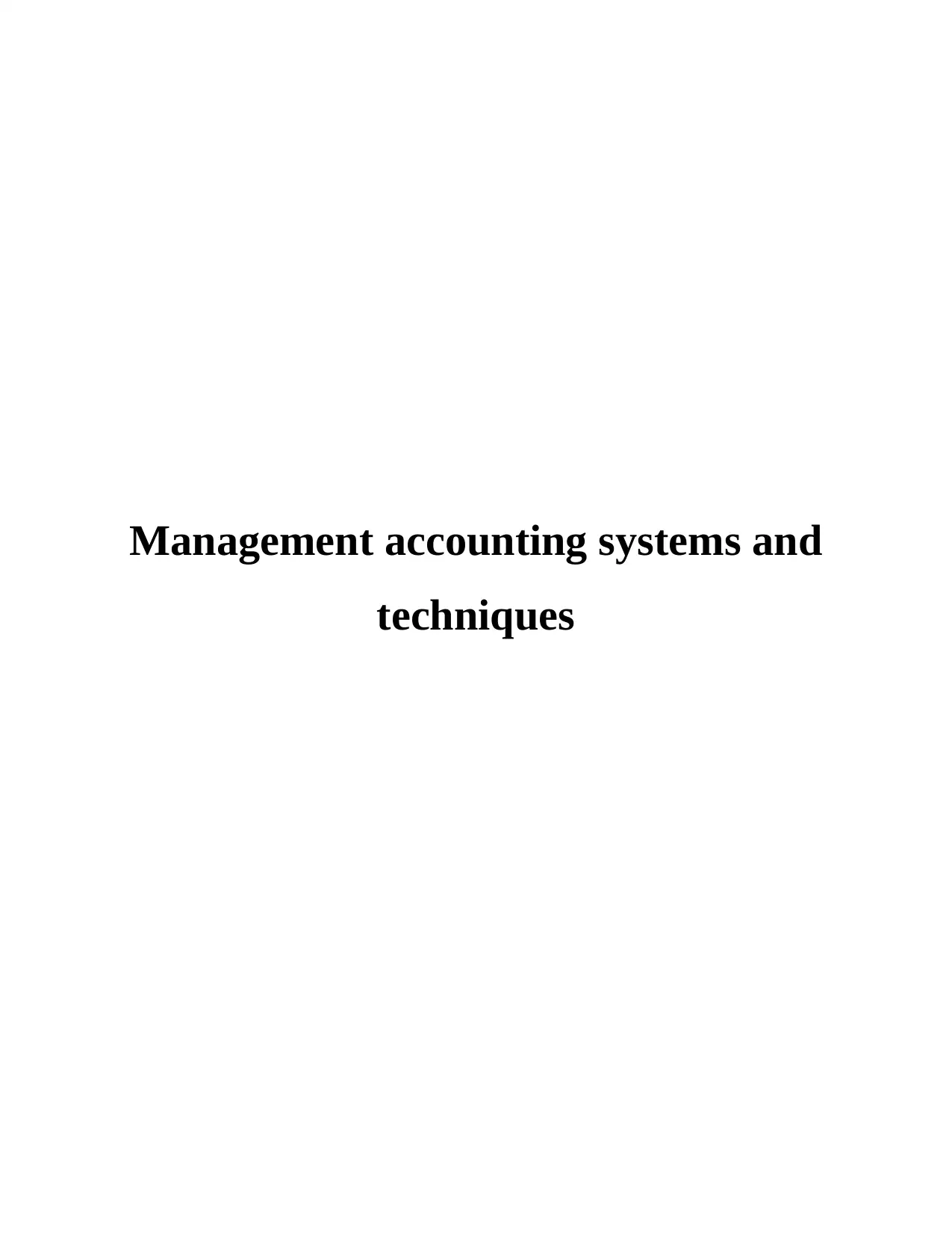
Management accounting systems and
techniques
techniques
Paraphrase This Document
Need a fresh take? Get an instant paraphrase of this document with our AI Paraphraser
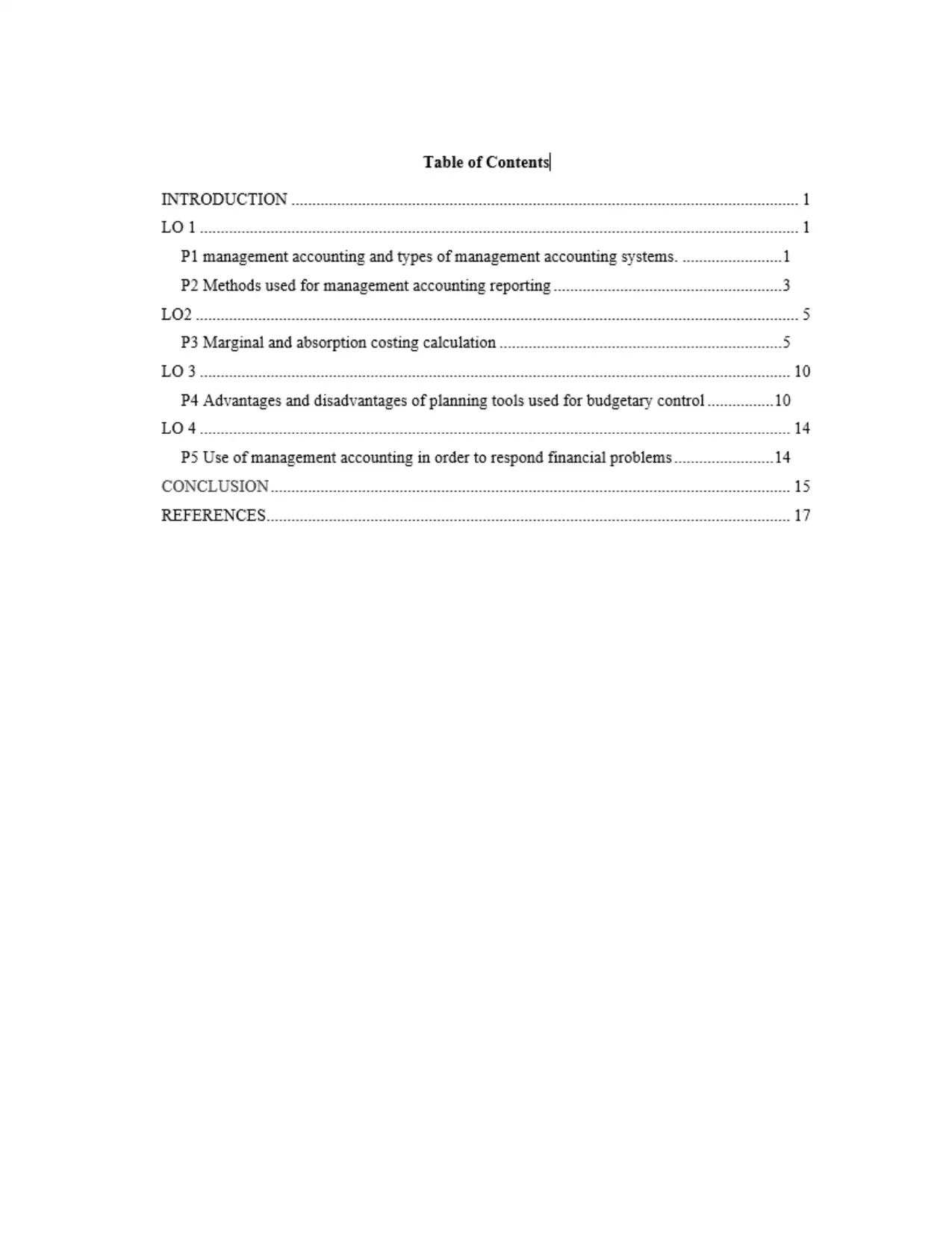
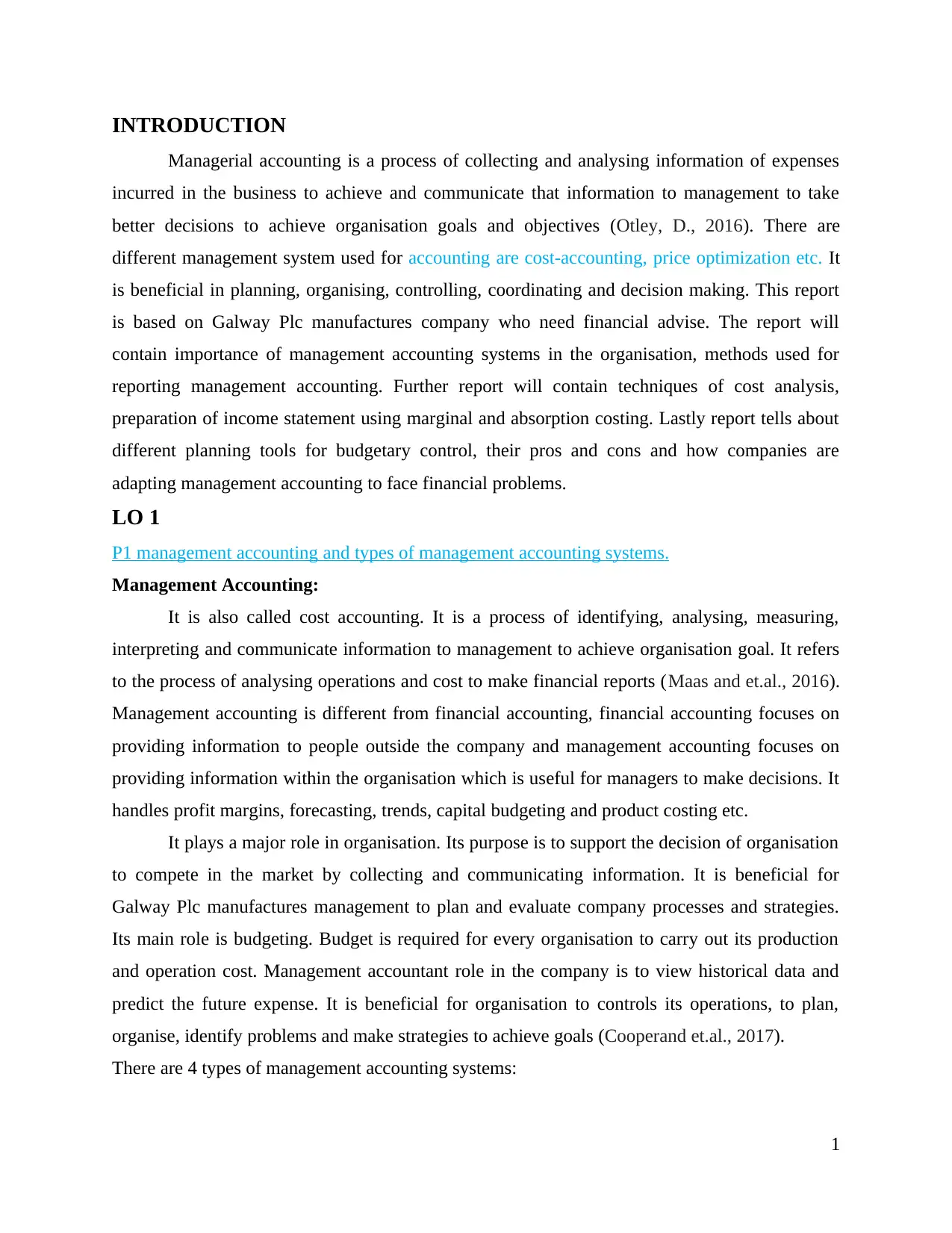
INTRODUCTION
Managerial accounting is a process of collecting and analysing information of expenses
incurred in the business to achieve and communicate that information to management to take
better decisions to achieve organisation goals and objectives (Otley, D., 2016). There are
different management system used for accounting are cost-accounting, price optimization etc. It
is beneficial in planning, organising, controlling, coordinating and decision making. This report
is based on Galway Plc manufactures company who need financial advise. The report will
contain importance of management accounting systems in the organisation, methods used for
reporting management accounting. Further report will contain techniques of cost analysis,
preparation of income statement using marginal and absorption costing. Lastly report tells about
different planning tools for budgetary control, their pros and cons and how companies are
adapting management accounting to face financial problems.
LO 1
P1 management accounting and types of management accounting systems.
Management Accounting:
It is also called cost accounting. It is a process of identifying, analysing, measuring,
interpreting and communicate information to management to achieve organisation goal. It refers
to the process of analysing operations and cost to make financial reports (Maas and et.al., 2016).
Management accounting is different from financial accounting, financial accounting focuses on
providing information to people outside the company and management accounting focuses on
providing information within the organisation which is useful for managers to make decisions. It
handles profit margins, forecasting, trends, capital budgeting and product costing etc.
It plays a major role in organisation. Its purpose is to support the decision of organisation
to compete in the market by collecting and communicating information. It is beneficial for
Galway Plc manufactures management to plan and evaluate company processes and strategies.
Its main role is budgeting. Budget is required for every organisation to carry out its production
and operation cost. Management accountant role in the company is to view historical data and
predict the future expense. It is beneficial for organisation to controls its operations, to plan,
organise, identify problems and make strategies to achieve goals (Cooperand et.al., 2017).
There are 4 types of management accounting systems:
1
Managerial accounting is a process of collecting and analysing information of expenses
incurred in the business to achieve and communicate that information to management to take
better decisions to achieve organisation goals and objectives (Otley, D., 2016). There are
different management system used for accounting are cost-accounting, price optimization etc. It
is beneficial in planning, organising, controlling, coordinating and decision making. This report
is based on Galway Plc manufactures company who need financial advise. The report will
contain importance of management accounting systems in the organisation, methods used for
reporting management accounting. Further report will contain techniques of cost analysis,
preparation of income statement using marginal and absorption costing. Lastly report tells about
different planning tools for budgetary control, their pros and cons and how companies are
adapting management accounting to face financial problems.
LO 1
P1 management accounting and types of management accounting systems.
Management Accounting:
It is also called cost accounting. It is a process of identifying, analysing, measuring,
interpreting and communicate information to management to achieve organisation goal. It refers
to the process of analysing operations and cost to make financial reports (Maas and et.al., 2016).
Management accounting is different from financial accounting, financial accounting focuses on
providing information to people outside the company and management accounting focuses on
providing information within the organisation which is useful for managers to make decisions. It
handles profit margins, forecasting, trends, capital budgeting and product costing etc.
It plays a major role in organisation. Its purpose is to support the decision of organisation
to compete in the market by collecting and communicating information. It is beneficial for
Galway Plc manufactures management to plan and evaluate company processes and strategies.
Its main role is budgeting. Budget is required for every organisation to carry out its production
and operation cost. Management accountant role in the company is to view historical data and
predict the future expense. It is beneficial for organisation to controls its operations, to plan,
organise, identify problems and make strategies to achieve goals (Cooperand et.al., 2017).
There are 4 types of management accounting systems:
1
⊘ This is a preview!⊘
Do you want full access?
Subscribe today to unlock all pages.

Trusted by 1+ million students worldwide
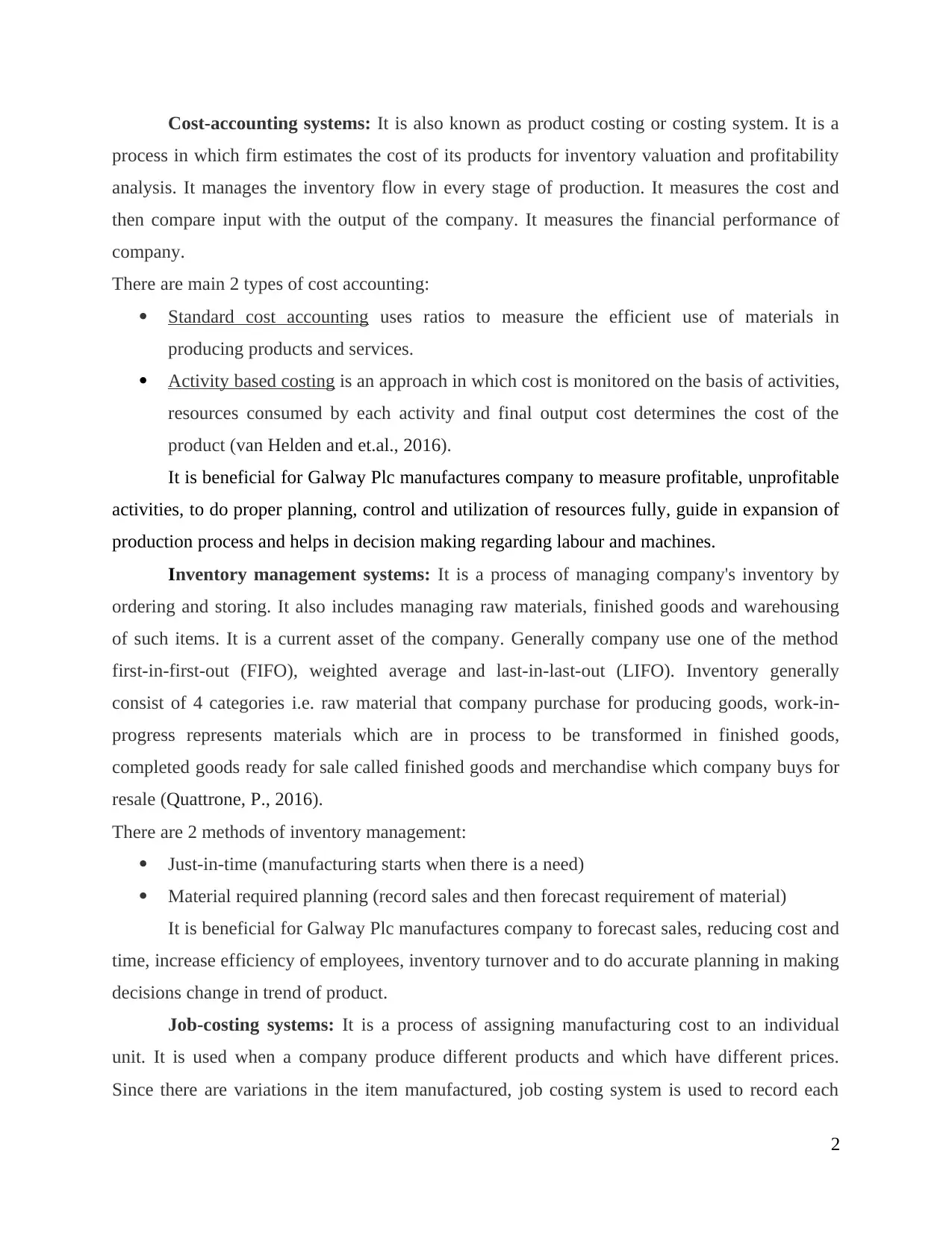
Cost-accounting systems: It is also known as product costing or costing system. It is a
process in which firm estimates the cost of its products for inventory valuation and profitability
analysis. It manages the inventory flow in every stage of production. It measures the cost and
then compare input with the output of the company. It measures the financial performance of
company.
There are main 2 types of cost accounting:
Standard cost accounting uses ratios to measure the efficient use of materials in
producing products and services.
Activity based costing is an approach in which cost is monitored on the basis of activities,
resources consumed by each activity and final output cost determines the cost of the
product (van Helden and et.al., 2016).
It is beneficial for Galway Plc manufactures company to measure profitable, unprofitable
activities, to do proper planning, control and utilization of resources fully, guide in expansion of
production process and helps in decision making regarding labour and machines.
Inventory management systems: It is a process of managing company's inventory by
ordering and storing. It also includes managing raw materials, finished goods and warehousing
of such items. It is a current asset of the company. Generally company use one of the method
first-in-first-out (FIFO), weighted average and last-in-last-out (LIFO). Inventory generally
consist of 4 categories i.e. raw material that company purchase for producing goods, work-in-
progress represents materials which are in process to be transformed in finished goods,
completed goods ready for sale called finished goods and merchandise which company buys for
resale (Quattrone, P., 2016).
There are 2 methods of inventory management:
Just-in-time (manufacturing starts when there is a need)
Material required planning (record sales and then forecast requirement of material)
It is beneficial for Galway Plc manufactures company to forecast sales, reducing cost and
time, increase efficiency of employees, inventory turnover and to do accurate planning in making
decisions change in trend of product.
Job-costing systems: It is a process of assigning manufacturing cost to an individual
unit. It is used when a company produce different products and which have different prices.
Since there are variations in the item manufactured, job costing system is used to record each
2
process in which firm estimates the cost of its products for inventory valuation and profitability
analysis. It manages the inventory flow in every stage of production. It measures the cost and
then compare input with the output of the company. It measures the financial performance of
company.
There are main 2 types of cost accounting:
Standard cost accounting uses ratios to measure the efficient use of materials in
producing products and services.
Activity based costing is an approach in which cost is monitored on the basis of activities,
resources consumed by each activity and final output cost determines the cost of the
product (van Helden and et.al., 2016).
It is beneficial for Galway Plc manufactures company to measure profitable, unprofitable
activities, to do proper planning, control and utilization of resources fully, guide in expansion of
production process and helps in decision making regarding labour and machines.
Inventory management systems: It is a process of managing company's inventory by
ordering and storing. It also includes managing raw materials, finished goods and warehousing
of such items. It is a current asset of the company. Generally company use one of the method
first-in-first-out (FIFO), weighted average and last-in-last-out (LIFO). Inventory generally
consist of 4 categories i.e. raw material that company purchase for producing goods, work-in-
progress represents materials which are in process to be transformed in finished goods,
completed goods ready for sale called finished goods and merchandise which company buys for
resale (Quattrone, P., 2016).
There are 2 methods of inventory management:
Just-in-time (manufacturing starts when there is a need)
Material required planning (record sales and then forecast requirement of material)
It is beneficial for Galway Plc manufactures company to forecast sales, reducing cost and
time, increase efficiency of employees, inventory turnover and to do accurate planning in making
decisions change in trend of product.
Job-costing systems: It is a process of assigning manufacturing cost to an individual
unit. It is used when a company produce different products and which have different prices.
Since there are variations in the item manufactured, job costing system is used to record each
2
Paraphrase This Document
Need a fresh take? Get an instant paraphrase of this document with our AI Paraphraser
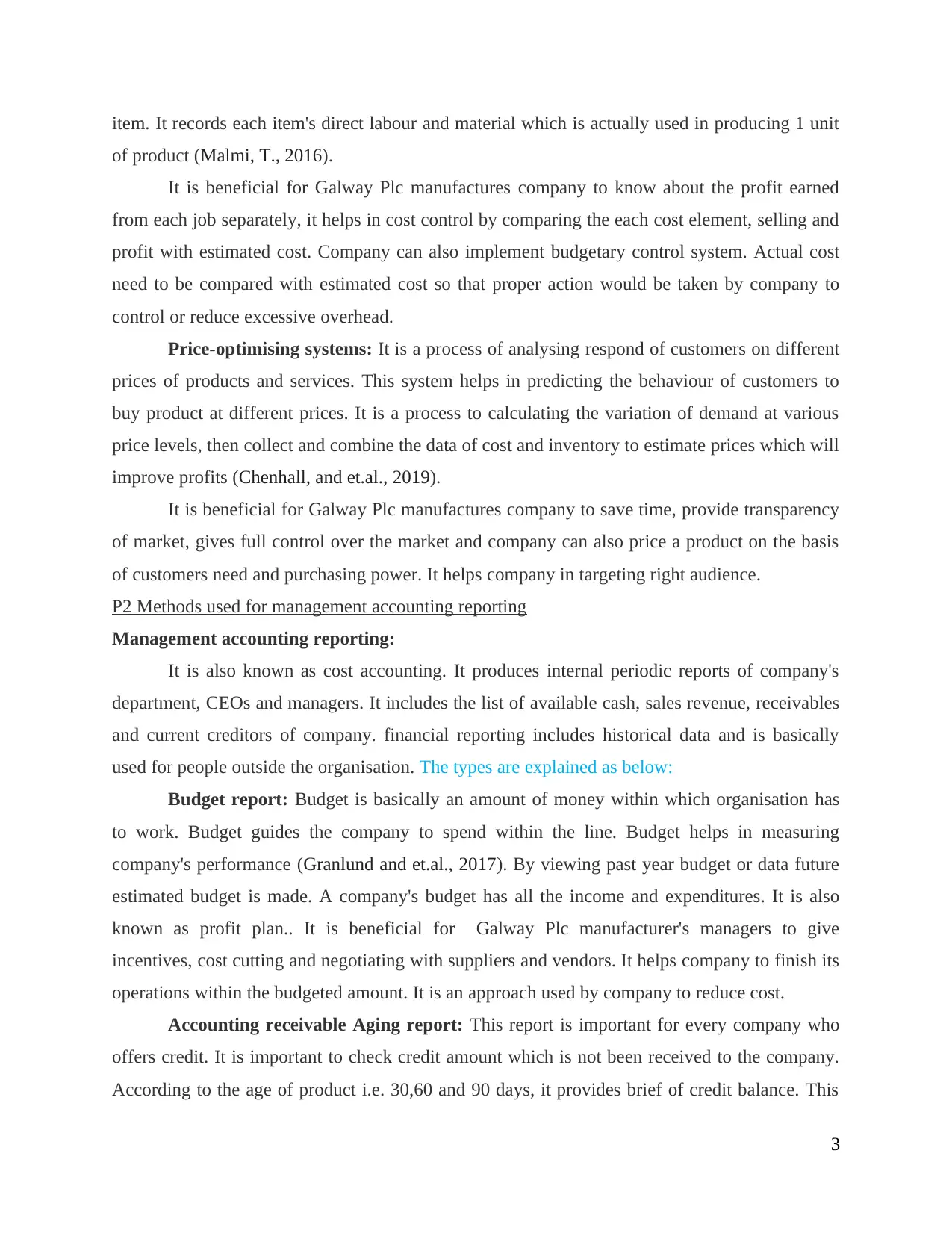
item. It records each item's direct labour and material which is actually used in producing 1 unit
of product (Malmi, T., 2016).
It is beneficial for Galway Plc manufactures company to know about the profit earned
from each job separately, it helps in cost control by comparing the each cost element, selling and
profit with estimated cost. Company can also implement budgetary control system. Actual cost
need to be compared with estimated cost so that proper action would be taken by company to
control or reduce excessive overhead.
Price-optimising systems: It is a process of analysing respond of customers on different
prices of products and services. This system helps in predicting the behaviour of customers to
buy product at different prices. It is a process to calculating the variation of demand at various
price levels, then collect and combine the data of cost and inventory to estimate prices which will
improve profits (Chenhall, and et.al., 2019).
It is beneficial for Galway Plc manufactures company to save time, provide transparency
of market, gives full control over the market and company can also price a product on the basis
of customers need and purchasing power. It helps company in targeting right audience.
P2 Methods used for management accounting reporting
Management accounting reporting:
It is also known as cost accounting. It produces internal periodic reports of company's
department, CEOs and managers. It includes the list of available cash, sales revenue, receivables
and current creditors of company. financial reporting includes historical data and is basically
used for people outside the organisation. The types are explained as below:
Budget report: Budget is basically an amount of money within which organisation has
to work. Budget guides the company to spend within the line. Budget helps in measuring
company's performance (Granlund and et.al., 2017). By viewing past year budget or data future
estimated budget is made. A company's budget has all the income and expenditures. It is also
known as profit plan.. It is beneficial for Galway Plc manufacturer's managers to give
incentives, cost cutting and negotiating with suppliers and vendors. It helps company to finish its
operations within the budgeted amount. It is an approach used by company to reduce cost.
Accounting receivable Aging report: This report is important for every company who
offers credit. It is important to check credit amount which is not been received to the company.
According to the age of product i.e. 30,60 and 90 days, it provides brief of credit balance. This
3
of product (Malmi, T., 2016).
It is beneficial for Galway Plc manufactures company to know about the profit earned
from each job separately, it helps in cost control by comparing the each cost element, selling and
profit with estimated cost. Company can also implement budgetary control system. Actual cost
need to be compared with estimated cost so that proper action would be taken by company to
control or reduce excessive overhead.
Price-optimising systems: It is a process of analysing respond of customers on different
prices of products and services. This system helps in predicting the behaviour of customers to
buy product at different prices. It is a process to calculating the variation of demand at various
price levels, then collect and combine the data of cost and inventory to estimate prices which will
improve profits (Chenhall, and et.al., 2019).
It is beneficial for Galway Plc manufactures company to save time, provide transparency
of market, gives full control over the market and company can also price a product on the basis
of customers need and purchasing power. It helps company in targeting right audience.
P2 Methods used for management accounting reporting
Management accounting reporting:
It is also known as cost accounting. It produces internal periodic reports of company's
department, CEOs and managers. It includes the list of available cash, sales revenue, receivables
and current creditors of company. financial reporting includes historical data and is basically
used for people outside the organisation. The types are explained as below:
Budget report: Budget is basically an amount of money within which organisation has
to work. Budget guides the company to spend within the line. Budget helps in measuring
company's performance (Granlund and et.al., 2017). By viewing past year budget or data future
estimated budget is made. A company's budget has all the income and expenditures. It is also
known as profit plan.. It is beneficial for Galway Plc manufacturer's managers to give
incentives, cost cutting and negotiating with suppliers and vendors. It helps company to finish its
operations within the budgeted amount. It is an approach used by company to reduce cost.
Accounting receivable Aging report: This report is important for every company who
offers credit. It is important to check credit amount which is not been received to the company.
According to the age of product i.e. 30,60 and 90 days, it provides brief of credit balance. This
3
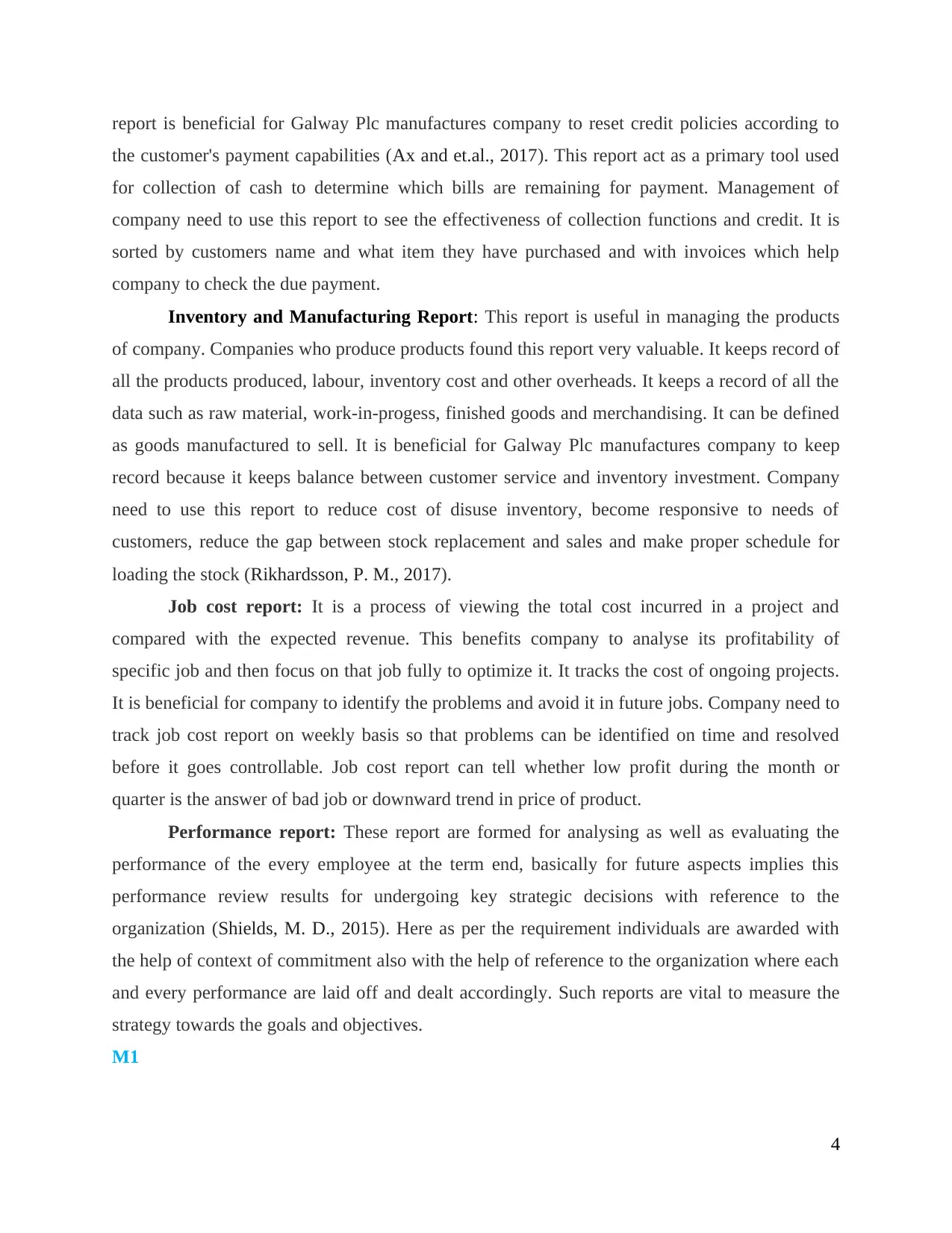
report is beneficial for Galway Plc manufactures company to reset credit policies according to
the customer's payment capabilities (Ax and et.al., 2017). This report act as a primary tool used
for collection of cash to determine which bills are remaining for payment. Management of
company need to use this report to see the effectiveness of collection functions and credit. It is
sorted by customers name and what item they have purchased and with invoices which help
company to check the due payment.
Inventory and Manufacturing Report: This report is useful in managing the products
of company. Companies who produce products found this report very valuable. It keeps record of
all the products produced, labour, inventory cost and other overheads. It keeps a record of all the
data such as raw material, work-in-progess, finished goods and merchandising. It can be defined
as goods manufactured to sell. It is beneficial for Galway Plc manufactures company to keep
record because it keeps balance between customer service and inventory investment. Company
need to use this report to reduce cost of disuse inventory, become responsive to needs of
customers, reduce the gap between stock replacement and sales and make proper schedule for
loading the stock (Rikhardsson, P. M., 2017).
Job cost report: It is a process of viewing the total cost incurred in a project and
compared with the expected revenue. This benefits company to analyse its profitability of
specific job and then focus on that job fully to optimize it. It tracks the cost of ongoing projects.
It is beneficial for company to identify the problems and avoid it in future jobs. Company need to
track job cost report on weekly basis so that problems can be identified on time and resolved
before it goes controllable. Job cost report can tell whether low profit during the month or
quarter is the answer of bad job or downward trend in price of product.
Performance report: These report are formed for analysing as well as evaluating the
performance of the every employee at the term end, basically for future aspects implies this
performance review results for undergoing key strategic decisions with reference to the
organization (Shields, M. D., 2015). Here as per the requirement individuals are awarded with
the help of context of commitment also with the help of reference to the organization where each
and every performance are laid off and dealt accordingly. Such reports are vital to measure the
strategy towards the goals and objectives.
M1
4
the customer's payment capabilities (Ax and et.al., 2017). This report act as a primary tool used
for collection of cash to determine which bills are remaining for payment. Management of
company need to use this report to see the effectiveness of collection functions and credit. It is
sorted by customers name and what item they have purchased and with invoices which help
company to check the due payment.
Inventory and Manufacturing Report: This report is useful in managing the products
of company. Companies who produce products found this report very valuable. It keeps record of
all the products produced, labour, inventory cost and other overheads. It keeps a record of all the
data such as raw material, work-in-progess, finished goods and merchandising. It can be defined
as goods manufactured to sell. It is beneficial for Galway Plc manufactures company to keep
record because it keeps balance between customer service and inventory investment. Company
need to use this report to reduce cost of disuse inventory, become responsive to needs of
customers, reduce the gap between stock replacement and sales and make proper schedule for
loading the stock (Rikhardsson, P. M., 2017).
Job cost report: It is a process of viewing the total cost incurred in a project and
compared with the expected revenue. This benefits company to analyse its profitability of
specific job and then focus on that job fully to optimize it. It tracks the cost of ongoing projects.
It is beneficial for company to identify the problems and avoid it in future jobs. Company need to
track job cost report on weekly basis so that problems can be identified on time and resolved
before it goes controllable. Job cost report can tell whether low profit during the month or
quarter is the answer of bad job or downward trend in price of product.
Performance report: These report are formed for analysing as well as evaluating the
performance of the every employee at the term end, basically for future aspects implies this
performance review results for undergoing key strategic decisions with reference to the
organization (Shields, M. D., 2015). Here as per the requirement individuals are awarded with
the help of context of commitment also with the help of reference to the organization where each
and every performance are laid off and dealt accordingly. Such reports are vital to measure the
strategy towards the goals and objectives.
M1
4
⊘ This is a preview!⊘
Do you want full access?
Subscribe today to unlock all pages.

Trusted by 1+ million students worldwide
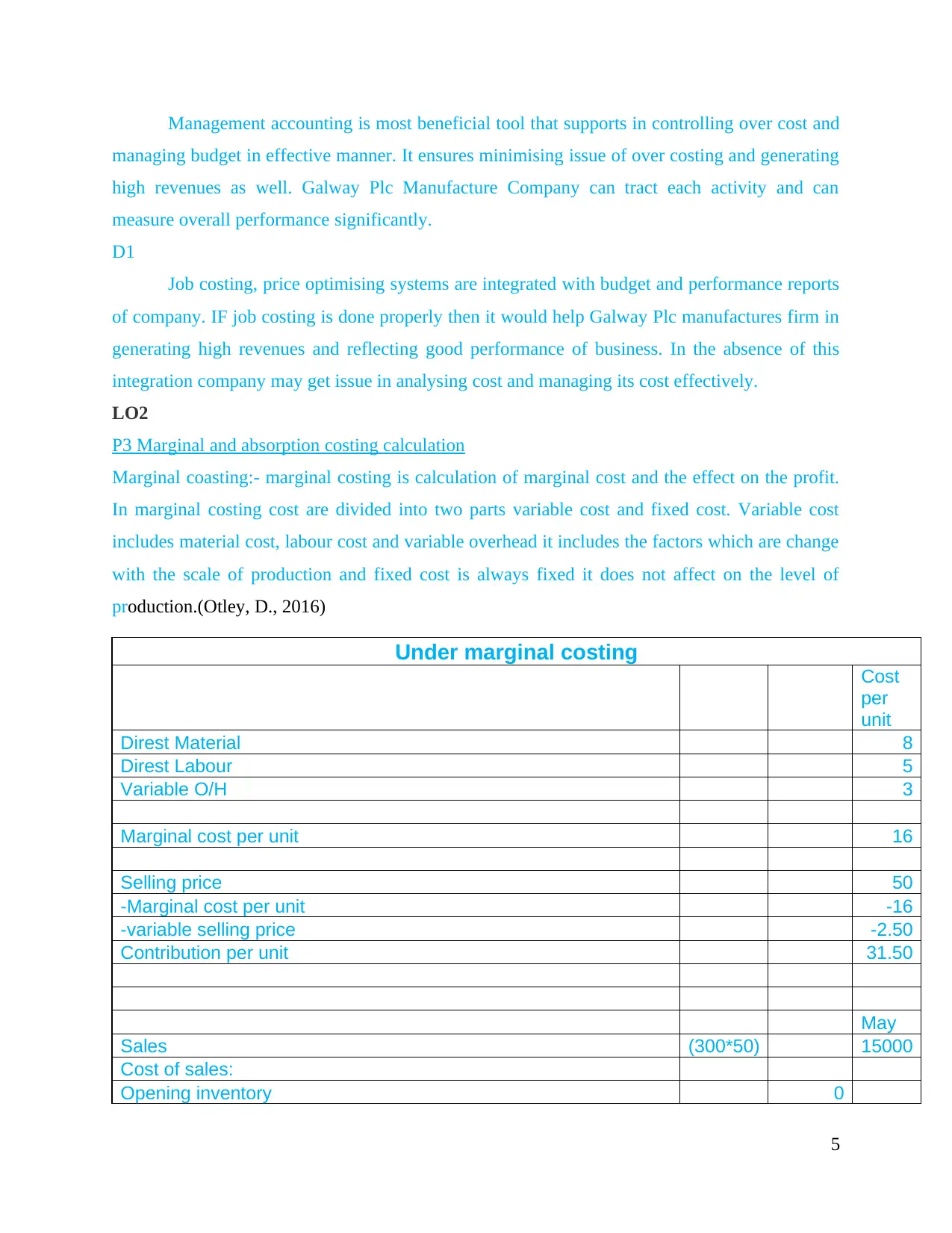
Management accounting is most beneficial tool that supports in controlling over cost and
managing budget in effective manner. It ensures minimising issue of over costing and generating
high revenues as well. Galway Plc Manufacture Company can tract each activity and can
measure overall performance significantly.
D1
Job costing, price optimising systems are integrated with budget and performance reports
of company. IF job costing is done properly then it would help Galway Plc manufactures firm in
generating high revenues and reflecting good performance of business. In the absence of this
integration company may get issue in analysing cost and managing its cost effectively.
LO2
P3 Marginal and absorption costing calculation
Marginal coasting:- marginal costing is calculation of marginal cost and the effect on the profit.
In marginal costing cost are divided into two parts variable cost and fixed cost. Variable cost
includes material cost, labour cost and variable overhead it includes the factors which are change
with the scale of production and fixed cost is always fixed it does not affect on the level of
production.(Otley, D., 2016)
Under marginal costing
Cost
per
unit
Direst Material 8
Direst Labour 5
Variable O/H 3
Marginal cost per unit 16
Selling price 50
-Marginal cost per unit -16
-variable selling price -2.50
Contribution per unit 31.50
May
Sales (300*50) 15000
Cost of sales:
Opening inventory 0
5
managing budget in effective manner. It ensures minimising issue of over costing and generating
high revenues as well. Galway Plc Manufacture Company can tract each activity and can
measure overall performance significantly.
D1
Job costing, price optimising systems are integrated with budget and performance reports
of company. IF job costing is done properly then it would help Galway Plc manufactures firm in
generating high revenues and reflecting good performance of business. In the absence of this
integration company may get issue in analysing cost and managing its cost effectively.
LO2
P3 Marginal and absorption costing calculation
Marginal coasting:- marginal costing is calculation of marginal cost and the effect on the profit.
In marginal costing cost are divided into two parts variable cost and fixed cost. Variable cost
includes material cost, labour cost and variable overhead it includes the factors which are change
with the scale of production and fixed cost is always fixed it does not affect on the level of
production.(Otley, D., 2016)
Under marginal costing
Cost
per
unit
Direst Material 8
Direst Labour 5
Variable O/H 3
Marginal cost per unit 16
Selling price 50
-Marginal cost per unit -16
-variable selling price -2.50
Contribution per unit 31.50
May
Sales (300*50) 15000
Cost of sales:
Opening inventory 0
5
Paraphrase This Document
Need a fresh take? Get an instant paraphrase of this document with our AI Paraphraser
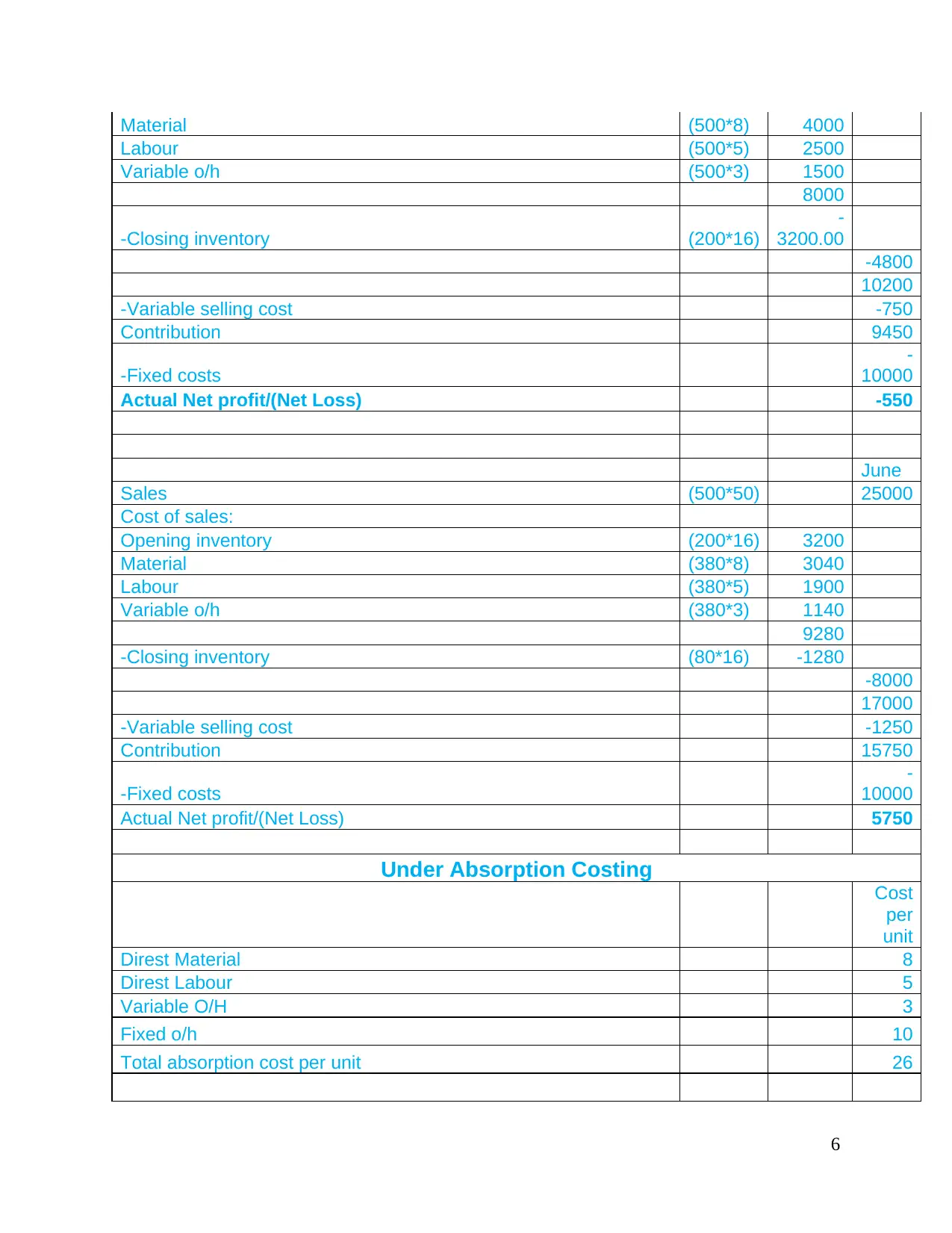
Material (500*8) 4000
Labour (500*5) 2500
Variable o/h (500*3) 1500
8000
-Closing inventory (200*16)
-
3200.00
-4800
10200
-Variable selling cost -750
Contribution 9450
-Fixed costs
-
10000
Actual Net profit/(Net Loss) -550
June
Sales (500*50) 25000
Cost of sales:
Opening inventory (200*16) 3200
Material (380*8) 3040
Labour (380*5) 1900
Variable o/h (380*3) 1140
9280
-Closing inventory (80*16) -1280
-8000
17000
-Variable selling cost -1250
Contribution 15750
-Fixed costs
-
10000
Actual Net profit/(Net Loss) 5750
Under Absorption Costing
Cost
per
unit
Direst Material 8
Direst Labour 5
Variable O/H 3
Fixed o/h 10
Total absorption cost per unit 26
6
Labour (500*5) 2500
Variable o/h (500*3) 1500
8000
-Closing inventory (200*16)
-
3200.00
-4800
10200
-Variable selling cost -750
Contribution 9450
-Fixed costs
-
10000
Actual Net profit/(Net Loss) -550
June
Sales (500*50) 25000
Cost of sales:
Opening inventory (200*16) 3200
Material (380*8) 3040
Labour (380*5) 1900
Variable o/h (380*3) 1140
9280
-Closing inventory (80*16) -1280
-8000
17000
-Variable selling cost -1250
Contribution 15750
-Fixed costs
-
10000
Actual Net profit/(Net Loss) 5750
Under Absorption Costing
Cost
per
unit
Direst Material 8
Direst Labour 5
Variable O/H 3
Fixed o/h 10
Total absorption cost per unit 26
6
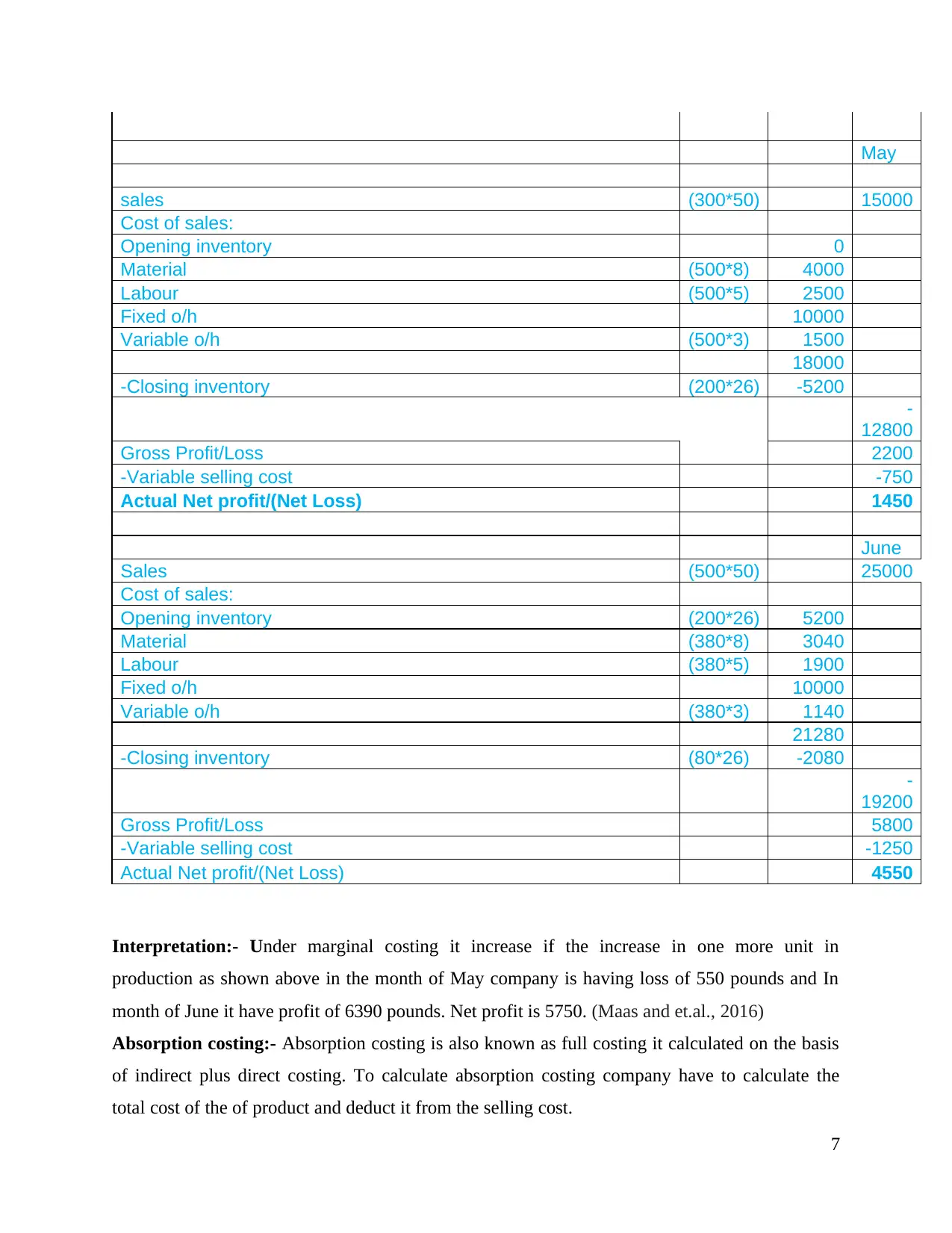
May
sales (300*50) 15000
Cost of sales:
Opening inventory 0
Material (500*8) 4000
Labour (500*5) 2500
Fixed o/h 10000
Variable o/h (500*3) 1500
18000
-Closing inventory (200*26) -5200
-
12800
Gross Profit/Loss 2200
-Variable selling cost -750
Actual Net profit/(Net Loss) 1450
June
Sales (500*50) 25000
Cost of sales:
Opening inventory (200*26) 5200
Material (380*8) 3040
Labour (380*5) 1900
Fixed o/h 10000
Variable o/h (380*3) 1140
21280
-Closing inventory (80*26) -2080
-
19200
Gross Profit/Loss 5800
-Variable selling cost -1250
Actual Net profit/(Net Loss) 4550
Interpretation:- Under marginal costing it increase if the increase in one more unit in
production as shown above in the month of May company is having loss of 550 pounds and In
month of June it have profit of 6390 pounds. Net profit is 5750. (Maas and et.al., 2016)
Absorption costing:- Absorption costing is also known as full costing it calculated on the basis
of indirect plus direct costing. To calculate absorption costing company have to calculate the
total cost of the of product and deduct it from the selling cost.
7
sales (300*50) 15000
Cost of sales:
Opening inventory 0
Material (500*8) 4000
Labour (500*5) 2500
Fixed o/h 10000
Variable o/h (500*3) 1500
18000
-Closing inventory (200*26) -5200
-
12800
Gross Profit/Loss 2200
-Variable selling cost -750
Actual Net profit/(Net Loss) 1450
June
Sales (500*50) 25000
Cost of sales:
Opening inventory (200*26) 5200
Material (380*8) 3040
Labour (380*5) 1900
Fixed o/h 10000
Variable o/h (380*3) 1140
21280
-Closing inventory (80*26) -2080
-
19200
Gross Profit/Loss 5800
-Variable selling cost -1250
Actual Net profit/(Net Loss) 4550
Interpretation:- Under marginal costing it increase if the increase in one more unit in
production as shown above in the month of May company is having loss of 550 pounds and In
month of June it have profit of 6390 pounds. Net profit is 5750. (Maas and et.al., 2016)
Absorption costing:- Absorption costing is also known as full costing it calculated on the basis
of indirect plus direct costing. To calculate absorption costing company have to calculate the
total cost of the of product and deduct it from the selling cost.
7
⊘ This is a preview!⊘
Do you want full access?
Subscribe today to unlock all pages.

Trusted by 1+ million students worldwide
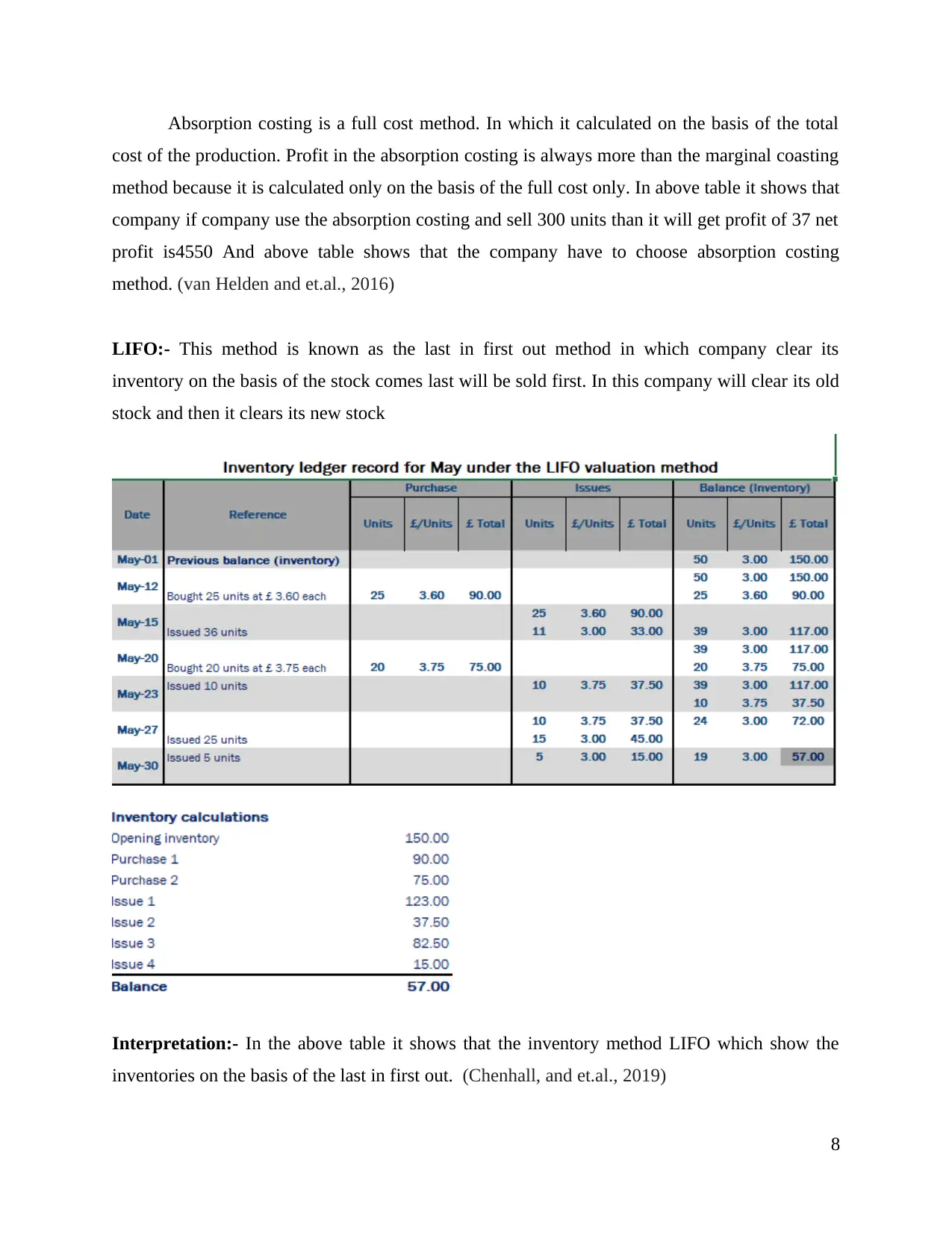
Absorption costing is a full cost method. In which it calculated on the basis of the total
cost of the production. Profit in the absorption costing is always more than the marginal coasting
method because it is calculated only on the basis of the full cost only. In above table it shows that
company if company use the absorption costing and sell 300 units than it will get profit of 37 net
profit is4550 And above table shows that the company have to choose absorption costing
method. (van Helden and et.al., 2016)
LIFO:- This method is known as the last in first out method in which company clear its
inventory on the basis of the stock comes last will be sold first. In this company will clear its old
stock and then it clears its new stock
Interpretation:- In the above table it shows that the inventory method LIFO which show the
inventories on the basis of the last in first out. (Chenhall, and et.al., 2019)
8
cost of the production. Profit in the absorption costing is always more than the marginal coasting
method because it is calculated only on the basis of the full cost only. In above table it shows that
company if company use the absorption costing and sell 300 units than it will get profit of 37 net
profit is4550 And above table shows that the company have to choose absorption costing
method. (van Helden and et.al., 2016)
LIFO:- This method is known as the last in first out method in which company clear its
inventory on the basis of the stock comes last will be sold first. In this company will clear its old
stock and then it clears its new stock
Interpretation:- In the above table it shows that the inventory method LIFO which show the
inventories on the basis of the last in first out. (Chenhall, and et.al., 2019)
8
Paraphrase This Document
Need a fresh take? Get an instant paraphrase of this document with our AI Paraphraser
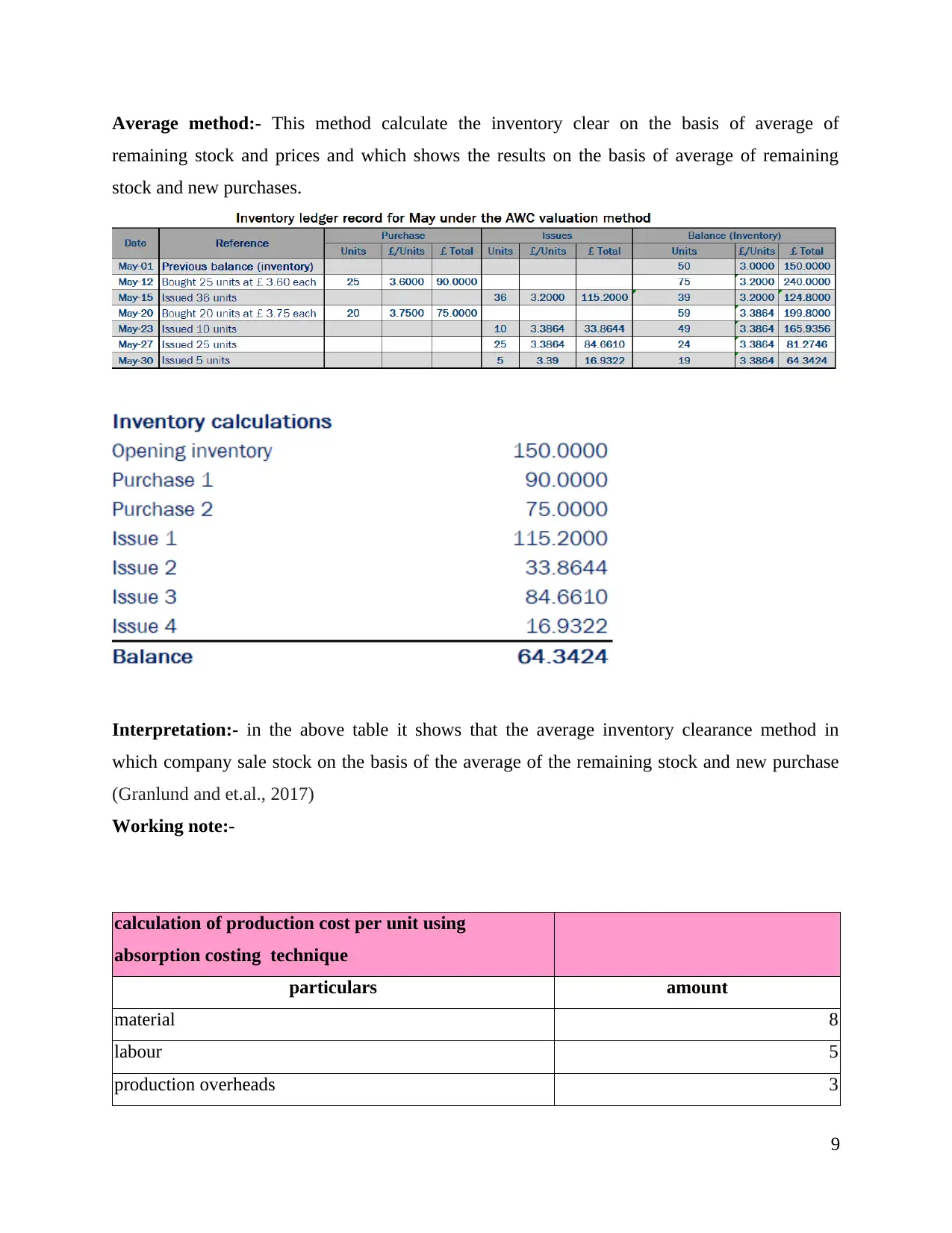
Average method:- This method calculate the inventory clear on the basis of average of
remaining stock and prices and which shows the results on the basis of average of remaining
stock and new purchases.
Interpretation:- in the above table it shows that the average inventory clearance method in
which company sale stock on the basis of the average of the remaining stock and new purchase
(Granlund and et.al., 2017)
Working note:-
calculation of production cost per unit using
absorption costing technique
particulars amount
material 8
labour 5
production overheads 3
9
remaining stock and prices and which shows the results on the basis of average of remaining
stock and new purchases.
Interpretation:- in the above table it shows that the average inventory clearance method in
which company sale stock on the basis of the average of the remaining stock and new purchase
(Granlund and et.al., 2017)
Working note:-
calculation of production cost per unit using
absorption costing technique
particulars amount
material 8
labour 5
production overheads 3
9
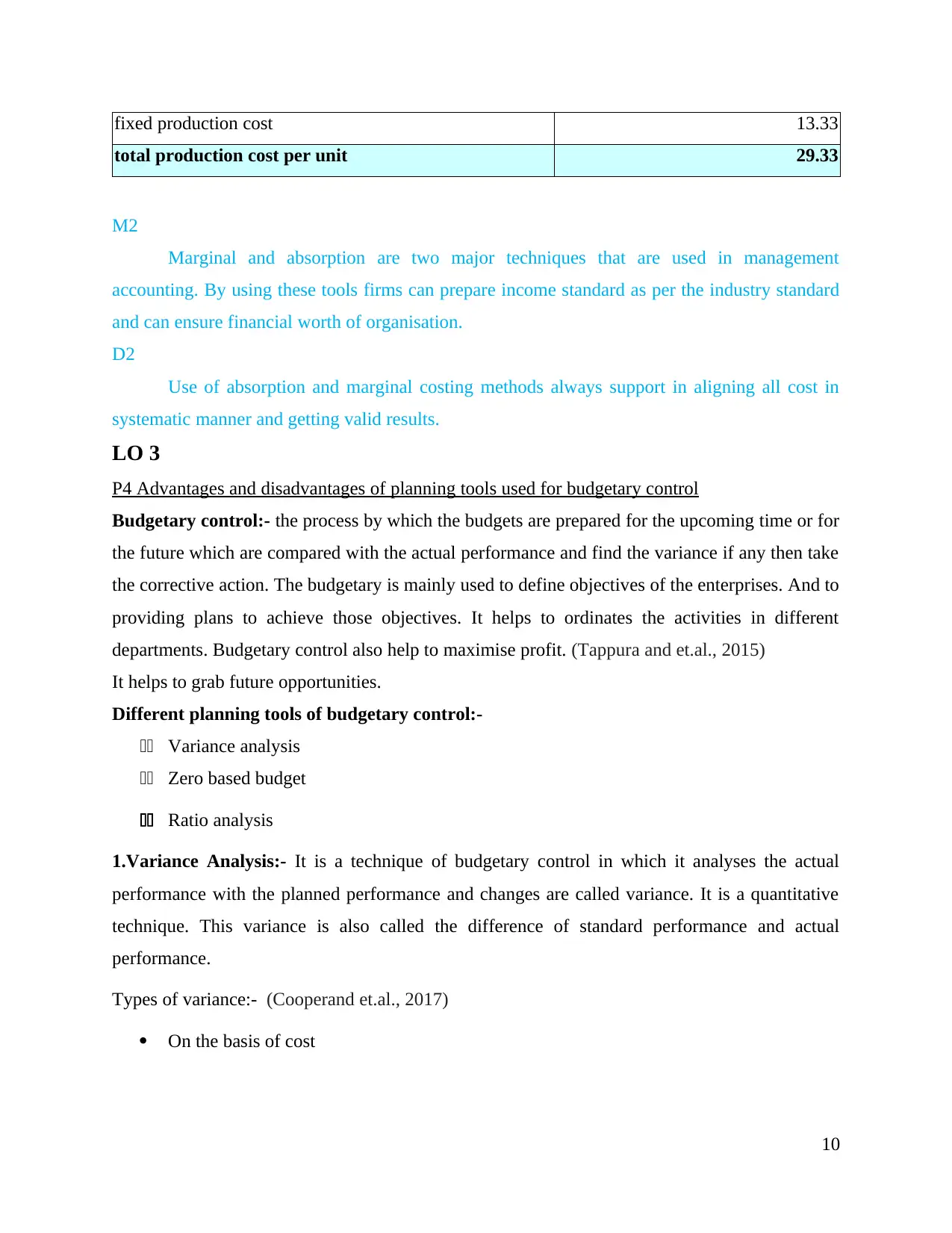
fixed production cost 13.33
total production cost per unit 29.33
M2
Marginal and absorption are two major techniques that are used in management
accounting. By using these tools firms can prepare income standard as per the industry standard
and can ensure financial worth of organisation.
D2
Use of absorption and marginal costing methods always support in aligning all cost in
systematic manner and getting valid results.
LO 3
P4 Advantages and disadvantages of planning tools used for budgetary control
Budgetary control:- the process by which the budgets are prepared for the upcoming time or for
the future which are compared with the actual performance and find the variance if any then take
the corrective action. The budgetary is mainly used to define objectives of the enterprises. And to
providing plans to achieve those objectives. It helps to ordinates the activities in different
departments. Budgetary control also help to maximise profit. (Tappura and et.al., 2015)
It helps to grab future opportunities.
Different planning tools of budgetary control:-
11 Variance analysis
11 Zero based budget
11 Ratio analysis
1.Variance Analysis:- It is a technique of budgetary control in which it analyses the actual
performance with the planned performance and changes are called variance. It is a quantitative
technique. This variance is also called the difference of standard performance and actual
performance.
Types of variance:- (Cooperand et.al., 2017)
On the basis of cost
10
total production cost per unit 29.33
M2
Marginal and absorption are two major techniques that are used in management
accounting. By using these tools firms can prepare income standard as per the industry standard
and can ensure financial worth of organisation.
D2
Use of absorption and marginal costing methods always support in aligning all cost in
systematic manner and getting valid results.
LO 3
P4 Advantages and disadvantages of planning tools used for budgetary control
Budgetary control:- the process by which the budgets are prepared for the upcoming time or for
the future which are compared with the actual performance and find the variance if any then take
the corrective action. The budgetary is mainly used to define objectives of the enterprises. And to
providing plans to achieve those objectives. It helps to ordinates the activities in different
departments. Budgetary control also help to maximise profit. (Tappura and et.al., 2015)
It helps to grab future opportunities.
Different planning tools of budgetary control:-
11 Variance analysis
11 Zero based budget
11 Ratio analysis
1.Variance Analysis:- It is a technique of budgetary control in which it analyses the actual
performance with the planned performance and changes are called variance. It is a quantitative
technique. This variance is also called the difference of standard performance and actual
performance.
Types of variance:- (Cooperand et.al., 2017)
On the basis of cost
10
⊘ This is a preview!⊘
Do you want full access?
Subscribe today to unlock all pages.

Trusted by 1+ million students worldwide
1 out of 19
Related Documents
Your All-in-One AI-Powered Toolkit for Academic Success.
+13062052269
info@desklib.com
Available 24*7 on WhatsApp / Email
![[object Object]](/_next/static/media/star-bottom.7253800d.svg)
Unlock your academic potential
Copyright © 2020–2025 A2Z Services. All Rights Reserved. Developed and managed by ZUCOL.





